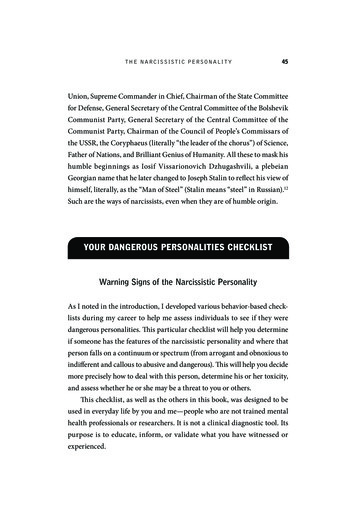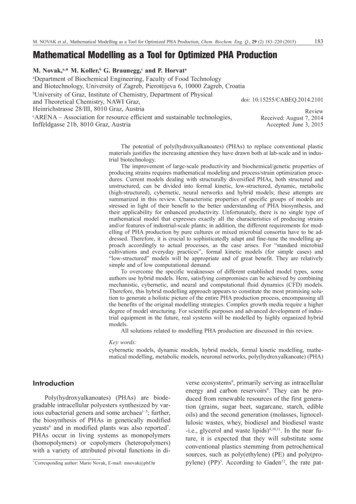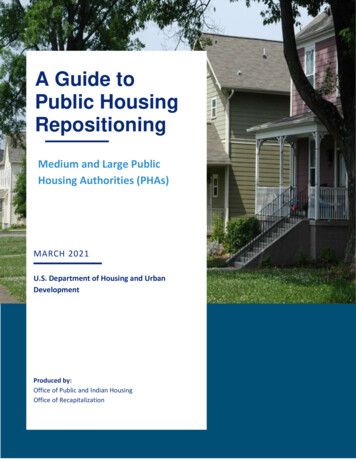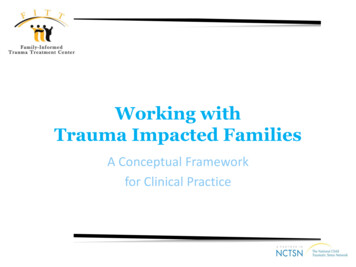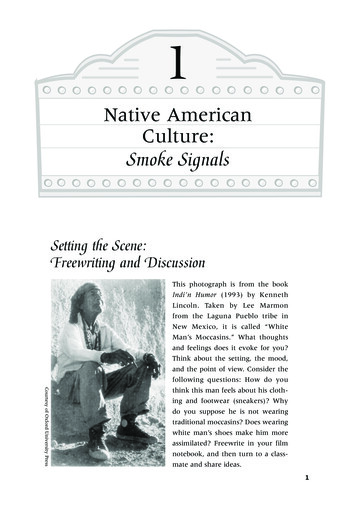
Transcription
PERSONALITIES& PHAsTackling Hazard Analysis Together
AuthorTony Robbinsonce said:“To effectively communicate,we must realize that we are alldifferent in the way we perceivethe world and use thisunderstanding as a guide to ourcommunication with others.”We couldn’t agree more.By Narenderpal Marwaha & James Tehrani2
The world is made up of differentpersonalities from extreme extroverts toindecisive introverts and everything inbetween, and people react to situationsdifferently. It’s what makes us unique.as many failures/hazards and potentialrisks as possible. That’s why havinga cooperative and collaborative teamcomposed of the individuals with theright experience and knowledge will bemost effective and efficient at creatinga comprehensive and high-quality study.When you go to a risk assessmentfacilitation meeting (be it a Hazards andOperability Analysis, or HAZOP; FailureMode and Effects Analysis, or FMEA; JobHazards Analysis, or JHA; Root CauseAnalysis, or RCA; etc.) you probably havea good idea of how everyone in the roomis going to behave. While most people willbe helpful and allow the meeting to runsmoothly, there are times participantsunintentionally make the brainstormingsession counterproductive.The risk assessment facilitator’s abilityto understand and manage the differentpersonalities is one of the key factors ingenerating a successful risk study. Thisis one of the reasons it’s so important tohave a skilled and experienced facilitatorleading your PHAs.Having conducted thousands of riskassessments for companies over theyears, we’ve worked with numerous riskstudy participants who made our jobeasier by being productive, attentive,cooperative and friendly. But not everystudy goes so swimmingly.You know the types: Some will naturallytake the authoritarian position and takecharge of the meeting even if they’re notrunning it, others will overanalyze minutedesign details, some will argue withcolleagues and others will avoid talkingat all costs.One of the factors is the inability ofthe participants to work well as a teamduring a facilitation, which can quicklyderail the process and, minimally, slowdown the process considerably. Here arejust a few personality types of risk studyparticipants we’ve come across, andsome insight into how we’ve learned todeal with them as facilitators.While vastly different personality typesin a room might be a good basis for areality show, they can be detrimental andperhaps even dangerous if left unfetteredin a risk assessment facilitation session.A risk study’s end game is to sniff out3
6 PERSONALITYTYPESWe’ve WitnessedDuring Hazard Studies4
ONEThe BossWhile this person could actually be the boss, what we mean here is the risk study participant who takes(or behaves in such a manner as to appear to take) total control of the meeting. This person may naturallybe a forceful character who makes the notoriously grumpy Louie De Palma (Danny DeVito) from “Taxi”seem easygoing. Colleagues are afraid to speak their mind in fear of angering The Boss, which meansthe free flow of original ideas and suggestions gets cut off entirely. This is a huge problem becauserigorous risk analysis involves taking input from everyone in the meeting. No one person can spot everypotential risk.The SolutionConsider bringing in an outsider or outsiders whodon’t regularly work with The Boss. If that’s notpossible, make sure to point out the meeting groundrules at the outset and outline expectations fromthe participants and the “rules of engagement.” Agood resource is the Harvard Business Reviewarticle “8 Ground Rules for Great Meetings.” Youcan also discuss specific situations with The Bossand come to an understanding of what needs to beaccomplished and how to get there.5
TWOThe AnalystThe bedrock of any risk assessment meeting is diving headfirst into the details ofthe process design. However, sometimes we come across The Analyst who goesoverboard slowing down the process or system and causing other participants tobecome disengaged from the discussion because of information overload.The SolutionOne way of managing important but off-topic discussions is through summarizingthe concepts and parking them for follow-up discussions outside the meeting.Make sure to establish in the meeting rules that participants are required to befocused on the question or topic at hand and should encourage each other to stayon track. That strategy and being concise and to the point will help ensure therisk assessment meeting runs smoothly. If there are concerns with the process orsystem that might affect the risk assessment but cannot be resolved during themeeting, they can be parked and assigned to be addressed outside the meeting.The facilitator would follow up with parked issues and make sure to close them.6
THREEThe MistakenTo err is human, but The Mistaken disregards andeven pooh-poohs the very notion that people are notperfect beings. No system or process is absolutelyperfect, and the potential for human error cannot beignored. The Mistaken tends to insist that if thingsare run properly, there should be no problems. It mightsound logical, but mistakes do happen. There aremany instances of well-meaning individuals being thecause or enablersof process incidents.The SolutionIgnoring human error is more than problematic—it’sdownright dangerous. People will make mistakesno matter what, so it’s essential to explain toThe Mistaken the importance of not ignoringmistakes during an evaluation and addressingwhat could happen if a mistake is made. Since theparticipants are likely to be personally involved withthe system or process they are analyzing, it is naturalto feel personally attacked since the nature of thePHA is to identify failures deliberately. It needs tobe established clearly in the meeting rules that thegoal is not to point at the individual but to addressthe potential for human error so that the risk of thatfailure is properly understood and further reduced.For more insight, we highly recommend the HarvardBusiness Review article “How to Run a Meeting.”Even though the article is four decades old, theinformation is still pertinent today.7
FOURThe GladiatorsCan’t we all just get along? Well, no.Sometimes we experience a situationwhere two people just cannot agree.Perhaps there’s a personality conflictor something personal going onbetween the individuals. While ahealthy discussion of opposing viewsis encouraged to properly understandthe various scenarios from differentperspectives, constant bickering canlead to gridlock and an unproductiverisk analysis. Gladiators can slowdown the risk assessment process andlead to higher study costs because ofdelays and the shifting of the team’sattention from the meeting objective.8
The SolutionAt minimum, the facilitator should be able tosit down with The Gladiators and explain howtheir fighting is disrupting the meeting. A PHArisk assessment is a serious undertaking thatdirectly affects process safety, and a poor PHAstudy can put a company and its employees atrisk if The Gladiators monopolize everyone’stime. Similarly, a risk assessment that is notdone well can negatively affect a company’sbottom line. A good facilitator should be able todeal with The Gladiators in a respectful but firmmanner and where possible use good humor tobring The Gladiators and meeting back on track.Another Harvard Business Review article, “GetYour Team to Stop Fighting and Start Working,”has good information on this very topic.9
FIVEThe TechieNowadays, many people have a hard time putting down their phones, tabletsor other gizmos for too long. But not giving a hazard study your full attentioncan lead to wasted time and likely less information-sharing. It’s not uncommonto have participants working on their emails or web surfing during the riskassessment, which definitely needs to be discouraged.The SolutionOf course, having ready access to a company’s internal network and the externalInternet also allows the participants to have direct access to the informationpertinent to the risk assessment. However, if emailing or web surfing becomea distraction for The Techies on your team, it might be best to restrict thataccess or, like many companies already do, move the meeting off-site to reducedisruptions. Risk assessments are onerous and can be exhausting. Havingaccess to the Internet does allow some individuals to get their information “fix”and get refreshed thereby allowing them to be able to concentrate better. So inthis case a careful balance needs to be established through meeting rules thatmake it clear that web surfing not related to the PHA, social media posting andonline game playing is allowed only during breaks.10
SIXThe TimidIt’s no crime to be shy, but not being able to offer an opinion during a riskassessment out of fear of embarrassment or even fear of repercussions can bejust as disruptive or counterproductive as The Boss trying to run the show. Part ofwhat makes a risk assessment meeting successful is gathering information fromthe people in the know, and the only way to learn what The Timid participant knowsis by listening to what they have to say. But they must be able to speak freely.The SolutionA facilitator will make sure to include The Timid inany discussion by asking their opinion. One of the keymeeting ground rules is for the participants to expresstheir views and participate in the conversation. Theselection of the team should include the right people interms of their skill sets, experience and qualificationspertaining to the process or system being analyzed.The participants are responsible for the content andessentially expected to contribute with theirthoughts and ideas. It is importantto learn about any concernsThe Timid might have aboutoffering honest feedback,and that should beaddressed as earlyas possible.11
An effectiveand efficient riskassessment studytakes a teamof peopleworking togethertoward one goal:to identify failures in the processor system and mitigate the risksto an acceptable level.One of the other main tasks of the facilitator, other than managing theteam, is capturing and properly recording the pertinent risk informationgenerated by the group. “As the Chinese proverb goes, ‘The palest ink isbetter than the best memory,’ ” wrote Paul Axtell in the Harvard BusinessReview article “Two Things to Do After Every Meeting.” “If you don’t capturethe conversation and put [it] into a form that can be easily retrieved later,the thinking and the agreements can be lost.”If your organization is ready for a risk assessment, contact us to set upa facilitation. Our experience will help you achieve the results you desire.
Narenderpal Marwaha is a seasonedoperational risk management consultantwith 15 years of experience at Sphera inproduct, project and training management,and consulting. He has worked withvarious customers in the manufacturingand process industries including preciousmetals, mining, defense, consumer goods,automotive,electronics,aerospace,and oil and gas. As director of productmanagement, he helped to develop numerous applications and solutionsfor both quality and process safety management. He is a skilled riskassessment facilitator and trainer of various risk analysis techniquesincluding HAZOP, What If, LOPA, FMEA and FTA. He currently managesSphera’s training services for enterprise platforms including Stature,IMPACT, Essential Suite, and opsInfo. He is a professional engineer.James Tehrani is Sphera’s content marketingmanager. He is an award-winning editor andwriter based in Chicago. Previously, Tehraniserved as managing editor of Workforcemagazine, a trade publication for humanresources executives.13
About SpheraFor more than 30 years, Sphera has been committed to creating a safer, more sustainable andproductive world by advancing operational excellence. Sphera is the largest global provider ofOperational Excellence software and information services with a focus on Environmental Health& Safety (EH&S), Operational Risk and Product Stewardship. The Chicago-based companyserves more than 3,000 customers and over 1 million individual users across 70 countries.Sphera is a portfolio company of Genstar Capital, a leading middle-market private equity firmfocused on the software, industrial technology, financial services and healthcare industries.www.sphera.comFor more information contact us at:sphera.com/contact-us/ 2018 Sphera. All Rights Reserved.
personalities from extreme extroverts to indecisive introverts and everything in between, and people react to situations differently. It's what makes us unique. . perhaps even dangerous if left unfettered in a risk assessment facilitation session. A risk study's end game is to sniff out as many failures/hazards and potential


